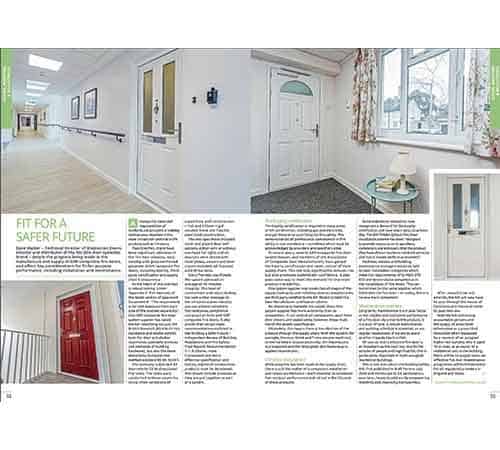Fit For a Safer Future – GRP Composite Fire Doors
Posted: 17th September 2021
Dave Walker, technical director of Distinction Doors, stockist and distributor of the fds (fire door systems) brand details the progress being made in the manufacture and supply of GRP composite fire doors, and key considerations for fit-for-purpose performance, including install and maintenance.
Amongst the many vital responsibilities of landlords and providers is building maintenance. Nowhere is this more critical than with risk to life products such as fire doors.
Post-Grenfell there have been significant advances in the fire door industry, most notably with Glass Reinforced Polyester (GRP) composite fire doors, including testing, third party certification and supply chain transparency.
At the heart of this overhaul is robust testing. Under Appendix C: Fire doorsets of the latest version of Approved Document B ‘The requirement is for test exposure from each side of the doorset separately.’ One GRP composite fire door system supplier has raised the bar, satisfying not just the British Standard (BS 476-22 Fire resistance and smoke control tests for door and shutter assemblies, openable windows and elements of building hardware) but also the more demanding European test method standard BS EN 1634-1.
The company subjected 44 doorsets to 22 bi-directional fire tests. The tests were conducted in three countries, using three variations of supporting wall construction – 150mm and 225mm rigid aerated block and flexible steel stud construction.
The test specimens included solid and glazed door leaf options, either with or without overhead fan lights and all doorsets were tested with letterplates, viewers and door closers included. All featured auto-throw locks.
Every fire test was filmed. The system achieved an average of 45 minutes integrity.
This level of commitment and robust testing has sent a clear message to the UK construction industry; you can achieve consistent fire resistance, compliance and peace of mind with GRP composite fire doors. It also proves that we can meet recommendations outlined in the Building a Safer Future – Independent Review of Building Regulations and Fire Safety: Final Report:
Recommendation 7.1: A clearer, more transparent and more effective specification and testing regime of construction products must be developed. This should include products as they are put together as part of a system.
Third party certification
Third party certification is required in many areas of UK construction, including gas and electricity, and yet there is no such thing for fire safety. The demonstration of professional competence in fire safety is non-mandatory – something which must be acknowledged by providers and specifiers alike.
In recent years several GRP composite fire door system houses, and members of the Association of Composite Door Manufacturers, have gained third party certification and taken control of their supply chain. This not only significantly reduces risk but also promotes stake-holder confidence. It also goes some way to meet the demand for improved product traceability.
One system supplier now insists that all stages of the supply chain up to and including doorset manufacture are third-party certified to the BM Trada Q-Mark Fire Door Manufacturer certification scheme.
By choosing to mandate the supply chain, this system supplier has more autonomy than its competitors. It can control all components apart from door closers and sealed units; however, these must match the tested specification.
Ultimately, this means there is less dilution of the product through the supply chain. With this system, for example, the door blank and frame are pre-machined, so the hardware locates positively, the intumescent is pre-applied and the letterplate also features pre-applied intumescent.
Certified Installation
Progress has been made in the supply chain, but there is still the matter of a competent installation and robust maintenance. Both are essential to consistent fire-resistant performance and critical in the life cycle of these products.
Some installation companies have recognised a demand for third party certification and have taken steps to achieve this. The BM TRADA Q-Mark Fire Door Installation scheme has been ‘…designed to provide reassurance to specifiers, contractors and end users that the product they have chosen has been installed correctly and that it should perform as intended.’
Facilities, estates and building maintenance managers would do well to seek installation companies which meet the requirements of Q-Mark STD 052 and demonstrate competence in the installation of fire doors. This can sometimes be the same supplier which fabricates the fire door – in reality, there is no one more competent.
Maintenance Matters
Long-term, maintenance is a crucial factor in the reliable and consistent performance of a fire door. As a risk to life product, it is a duty of care. A robust maintenance and auditing schedule is essential. As are regular inspections, if we are to avoid another tragedy like Grenfell.
Of course, every entrance fire door is as important as the next but, due to the volume of people and high footfall, this is particularly important in multi-occupied residential buildings.
This is one area which the Building Safety Bill, first published in draft form in July 2020 and introduced to UK parliament a year later, hopes to address by empowering residents and improving transparency.
After consultation and amends, the bill will now have to pass through the House of Commons and House of Lords to pass into law.
With the bill addressing accountable persons and the supply of prescribed information or a prescribed document when requested by a resident of an occupied higher-risk building who is aged 16 or over, or an owner of a residential unit in the building, there will be no wiggle room. An effective fire door maintenance programme will be fundamental for all registered providers in England and Wales.
Reproduced by kind permission of Red Hut Media.
As featured in PSBJ magazine.

